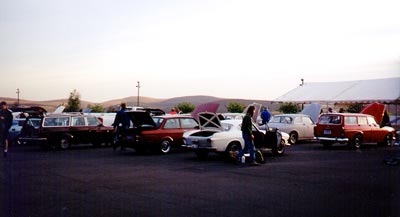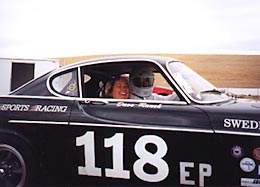Thunderhill
Phil Singher
editor@vclassics.com
The trip down went smoothly. We left our driveway in Vancouver, Washington, at 8:30 a.m. and were registered at the Blue Gum Inn in Willows at 5:30 p.m., where the Portland convoy joined us an hour later. Some moist Oregon gas had us sputtering a few times and brought the pinging back, but we'd fill the now-empty tank with something better in the morning. In the last few hours on the road, oil temps had risen to their old levels, which was mystifying. We all went to eat Chinese food at an ethnically transmogrified taco stand, came back to the Blue Gum, and slept if we could.
Marsha and I drove into Thunderhill Park at 7:30 the next morning, signed the obligatory waivers at the gate, and proceeded to registration. As I was meeting the very genial Lee Cordner and signing a bunch more waivers he handed me, the woman at the other end of the registration table jumped up, ran over and gave me a bear hug. It was Carron Rauch, looking so glamorous that I hadn't recognized her immediately. I signed her waivers, and then went to the track office window and signed theirs. We headed for the paddock with lots more papers and a fistful of stickers for our windshield. I had a neon green wristband on, too -- meaning I'd signed enough waivers to be allowed to drive on the track.

We found our spot, took everything out of the car and made a pile of it, sailed through tech inspection, put all the stickers on the windshield, and then it was time for the drivers' meeting. Bob Lord explained the rules, the flags and the turns, and made us all promise to behave. Too keep anyone from overcooking it into turn one at the end of the long straight, they'd used cones to make a little chicane just before it. Braking markers had been removed (I didn't fathom why) -- other than that, it was just like a real racetrack. Cars would run in three groups, each group having twenty minutes on the track each hour: slow cars or fast cars with slow drivers, faster cars with experienced drivers, and very fast cars whose drivers had racing licenses or equivalent experience. I ran off to rent a helmet and came back to find myself assigned to the middle group, where I doubted I belonged.
Thunderhill Park is owned by the SCCA, and their intent is to provide a "Disneyland for racers." It has several off-camber turns, lots of elevation changes, and feels more like one of those mountain roads sports car drivers seek out than it does like a racetrack, except for its very nice smooth surface. Turn five is the sharpest, and invisible just  over the top of a steep hill, which seemed intimidating until Dave Rauch explained the line to me: over the top of a steep hill, which seemed intimidating until Dave Rauch explained the line to me:
"Drive up the hill. Stop. Turn left. Go."
Not everyone had the benefit of Dave's advice, and we later saw more than a few cars attempting to turn while airborne. Fortunately, there's nice soft dirt to land in. Others came through it on pavement only to spin on the off-camber downhill right following. Ken Rodenbush developed an interesting technique of getting through it on two wheels, which worked fine for him.
California gas still has MBTE in it (which surprised me -- I thought that stuff had been universally banned as a Bad Idea), and I had to take a few degrees back off the timing. It didn't make any difference. There's no way my old B20E, derated from fuel injection to SU carbs, could have kept up with modified cars or turbos on the straight anyway. Cameron later complained of being held up in the turns by stock-suspensioned "appliances," but everyone was so far ahead of me entering the cone chicane that I never had that particular problem. Conversely, I don't remember anyone dogging my tail much, either.
By the fourth lap I was using lots of revs (how many I have no idea -- the tach is Smiths too) and the oil temp gauge had gone clear off the top of the scale. Water and oil pressure stayed fine, so I decided to ignore it. By lap ten or so, it was bugging me enough that I missed the downshift onto the straight and plowed through that turn. I took a 25 MPH cruise through the hot pits to see if I'd left my concentration there, which the starter guy didn't grasp at all. He stopped me, and I had to show my neon green wristband, demonstrate that the windows were actually down and not just clean, etc. Then he recognized me and didn't want to let me back out, as I'd already run and it must be someone else's turn now. We finally worked it out and I got a few more laps in before the session ended.
Back in the paddock, the car showed normal warm oil pressure at idle, even with the temp gauge still pegged. The new oil hoses were too hot to touch for long, but shouldn't they be? I wanted to believe the gauge had simply gone barking mad, and was busily convincing myself of that when I saw Cameron peering intently at the underside of his 122S. Funny noise coming from the rear suspension. We bounced the car a few times -- yeah, that noise. A few more bounces and we determined that it was coming from inside the trunk. It turned out to be the buckle on the little rubber strap that normally secures an Amazon's spare tire banging around.
Maybe that's some of the difference between real racers and "wannabe" racers like us. If the car's not on fire and pushrods aren't actually sticking up through the hood, real racers will keep racing. We get distracted by bogus gauges and noises in trunks. I found myself wishing I had something more in my stomach than one cup of thin instant coffee (compliments of the Blue Gum Inn), and wandered off to watch the real racers in group three do their thing.
Rain was forecast, and a few drops spattered windshields. I figured I'd better get in some more laps while the getting was good and snuck back out with group one. I hung back in the straight sections and had a clear run at most turns, except for some traffic jams at the top of the hill. After fifteen minutes, I felt I'd learned as much as I could with that group and took the pit lane before the session ended. If the rain held off, I'd do another run with group two in the afternoon and be ready for the time trials at the end of the day.
It was then that Jeff Perry, who'd parked his very nice 1800S behind ours, inquired about the pool of fluid our right rear tire was sitting in. It was all over the wheel, tire and wheel well, too. It smelled like gear oil, it felt like gear oil; it was, in fact, gear oil. This did not lube the cogs of my happiness one bit. Lunch would. I wandered off to find some. It helped, a little.
WD40 is overrated as a lubricant, but it makes a fine degreaser, which is why I always have a can of it in the toolbox. After a lot of squirting and wiping, I could see the leak was between the end of the axle housing and the brake backing plate. The same location on the left side also had a few drips. I found that I could tighten the lower bolts on both sides a fair amount just with an open-end wrench; the top ones, I couldn't budge. The last time someone had a wrench on those bolts, they were probably in Torslanda, Sweden -- I'd certainly never had a problem there before, unlike absolutely everywhere else on the car. Were they stretching? Cameron gave me a quart of gear oil, and it took the better part of it to top up the differential. I drove around the paddock and parking lot a few times and saw no new drips.
After quite a lot of deeply introspective pondering and a lesser amount of milling about aimlessly, I decided not to race the car anymore that day. If we'd been at Portland International Raceway, 10 miles from our house, I would have. But with another 90 miles to go south to Sacramento for the main part of the meet, and then close to 700 miles back home, I didn't want to push our luck.
Part three
Back to part one
|
